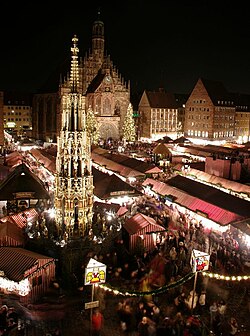
A Christmas market[a] is a street market associated with the celebration of Christmas during the four weeks of Advent.[1] These markets originated in Germany, but are now held in many countries.[2] Some in the U.S. have adapted the name to quasi-English Christkindlmarket, swapping German Markt and market.[3][4]
Christmas markets date to the Late Middle Ages in the German-speaking part of Europe and in many parts of the former Holy Roman Empire, which included many eastern regions of modern France.[2] They became a popular Advent custom during the Reformation era.[1] Dresden's Striezelmarkt was first held in 1434 and one of the first true Christmas markets;[5] earlier markets of the season were "December markets".[5][6] Early mentions of these "December markets" can be found in Vienna (1296),[7] Munich (1310),[5] Bautzen (1384),[8] and Frankfurt (1393).[9]
In many towns in Germany, Switzerland, and Austria, Advent is usually ushered in with the opening of the Christmas market or "Weihnachtsmarkt". In southern Germany, Switzerland and Austria, it is called a "Christkind(e)l(s)(i)markt" (German language, literally meaning "Christ child market"). Traditionally held in the town square, the market offers food, drinks and seasonal items for sale from open-air stalls, accompanied by traditional singing and dancing. On opening night at the Christkindlesmarkt in Nuremberg, and in some other towns, onlookers welcome the "Christkind" (originally boy Jesus, but often depicted as an angel-like girl), acted by a local child.
Cite error: There are <ref group=lower-alpha> tags or {{efn}} templates on this page, but the references will not show without a {{reflist|group=lower-alpha}} template or {{notelist}} template (see the help page).
- ^ a b Larsen, Timothy (2020). The Oxford Handbook of Christmas. Oxford University Press. p. 151. ISBN 978-0-19-883146-4.
Similarly, Christmas markets (aka Christkindlsmarkt) are common during Advent, a Reformation era tradition that has spread from Germany to other countries.
- ^ a b "German Christmas markets: Seasonal shopping at its finest". The Independent. 11 November 2012. Retrieved 8 December 2016.
- ^ "The Christkindlmarket 2022". Retrieved 31 December 2022.
- ^ "Christkindlmarket". Retrieved 31 December 2022.
- ^ a b c "Christmas Markets in Germany and Europe". The German Way & More. Retrieved 30 October 2019.
- ^ "Geschichte des Wiener Christkindlmarkts - Weihnachts- und Adventmarkt". www.wien.gv.at (in German). Archived from the original on 16 February 2020. Retrieved 30 October 2019.
- ^ "Christmas markets in Vienna". Austrian National Tourist Office. Retrieved 2 April 2017.
- ^ Darmstadt, IDL Software GmbH. "Weihnachtsmarkt in Bautzen - Weihnachten 2016". Retrieved 25 December 2016.
- ^ "Frankfurt Christmas Markets in Great Britain | Frankfurt Tourism". Frankfurt Tourismus. 27 December 2014. Archived from the original on 27 December 2014. Retrieved 30 October 2019.